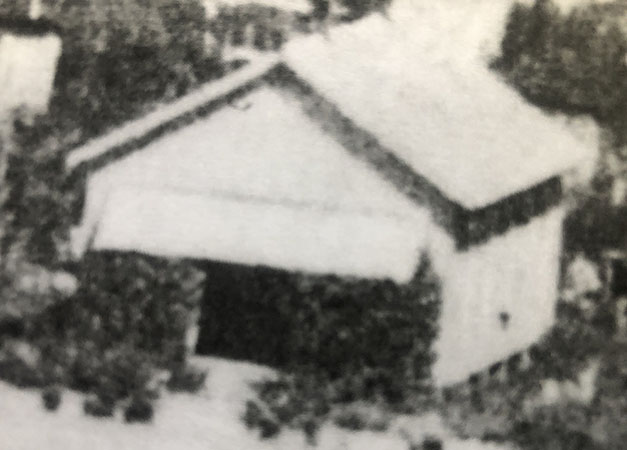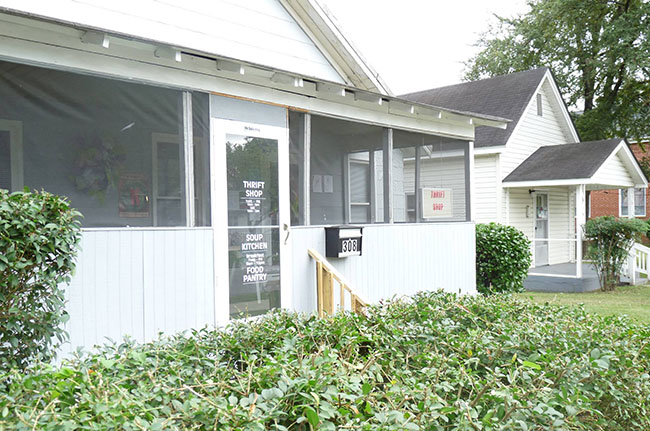History of the Smithfield Freedmen's Schoolhouse
The earliest known photograph of the Schoolhouse is from 1920:

Historical Timeline
- 1846
American Missionary Association (AMA) is founded.
- 1862
Educational Commission of Freedmen founded.
- July 1863
School for freedmen is established in NC on Roanoke Island.
- 1864
Educational Commission of Freedmen changes its name to New England Freedmen’s Aid Society.
- January 31, 1865
13th Amendment is passed, abolishing slavery and indentured servitude in the United States.
- 1865
U.S. Congress creates Bureau of Refugees, Freedmen, and Abandoned Lands (also known as Freedmen’s Bureau).
- January 1866
New England Freedmen’s Aid Society sends three teachers—Sarah Phelps, Jane Hamilton, and Clara Woodbury—to a school recently built by freedmen in Smithfield, NC.
- April 22, 1866
Schoolhouse mysteriously burns; classes are held in freedmen’s homes starting the next day.
- 1866-67
New England Freedmen’s Aid Society recalls teachers due to lack of funds; Jane Hamilton continues teaching through summer 1866 with no pay; local freedmen build new school on town property.
- 1867
AMA sends Mr. and Mrs. L. E. Bemis of Athol, Massachusetts, to teach at the Smithfield freedmen’s school; white students are enrolled.
- 1868
AMA sends Susan Hayes of Limerick, Maine, to replace Mr. and Mrs. Bemis; Hayes buys a half-acre lot at the corner of Fourth and Caswell Streets from local merchant Alfred Holland for $50 after raising money from friends in the North; federal Freedmen’s Bureau builds a two-room schoolhouse on Hayes’ lot.
- 1869
AMA sends teacher Mary Adele Brewer of Stockbridge, Massachusetts, to join Hayes; Hayes sells school lot to the American Missionary Association for $1.
- 1870
State of North Carolina takes over the school under a new public education law; Mary Elizabeth “Bettie” Morgan Brown, a free-born local woman, is listed as a teacher in the federal census.
- 1871
Smithfield School is now being called the Lincoln School; Hayes and Brewer leave Smithfield; school is taught by African American teachers.
- 1874
The New England Freedmen’s Aid Society disbands.
- 1886-1912
John W. Byrd becomes principal of Smithfield School, starts a college preparatory curriculum; two teacher’s residences are built.
- 1887
Johnston County public school system purchases adjacent lots for schoolhouse and teacher’s residences; Baptist church sells schoolhouse to school system to make room for a new church edifice; schoolhouse is moved to its current location; walls are added to create a third classroom and coat room.
- 1912-1918
John W. Byrd is principal of Smithfield (later renamed Johnston County) Training School, Johnston County’s first black high school.
- 1913
School is converted to a private residence, and its early history before John Byrd’s tenure is eventually forgotten.
- 2002
Research for a black history exhibit at the Johnston County Heritage Center reveals that the school was likely built by the Freedmen’s Bureau and predated John Byrd’s tenure.
- 2010
NC State Preservation Office is able to confirm former schoolhouse at 308 N. Fourth Street dates from the 1860s.
- 2013
HSF board member Rachel Ayers and her nonprofit organization, Helping Hands and Healing Hearts, Inc., used the former schoolhouse to provide a food pantry and clothing outlet for needy citizens:


Rachel Ayers at her desk in Thrift Shop
- 2016
First Missionary Baptist Church buys the property.
- 2017
Historic Smithfield Foundation, Inc., is created.
- 2019
FMBC conveys schoolhouse and lot to the Historic Smithfield Foundation.
- 2021
Restoration work begins.
Why is the Smithfield Schoolhouse unique?
Freedmen’s Bureau records show there were over 160 schools for freedmen operating in North Carolina between emancipation in 1865 and the General Assembly’s passage of a new school law in 1870. They were located in the following places: Anderson’s District, Asheville, Avon’s Plantation, Beatties Ford, Beaufort, Bethany, Bethphage, Boon Hill, Brookville, Bruce’s Crossroads, Brunswick, Buck Creek, Buffalo Ford, Burden’s District, Cain Creek, Cameron, Caraway District, Catawba, Camden District?, Cedar Grove, Cedar Landing, Chapel Hill, Charlotte, Clapps Foundry, Clarksburg, Clemmonsville, Clumsford Creek, Colerain, Company Shops, Concord, Cool Spring, Cotton Run, Crab Tree, Cunningham District, Dallas, Dawville, Deep River, Dudley, Durham, Estes Plantation, Edenton, Egypt, Elevation, Elizabeth City, Enfield, Fayetteville, Fenton, Fentress, Fishing Creek, Ford Creek, Forestville, Franklinton, Foster, Gaston, Gold Hill, Goldsboro, Good Hope, Graham, Greensboro, Greenville, Halifax, Haywood, Hazewell, Henderson, Hendersonville, Hertford, High Shoals, Hillsborough, Holmes Shops (Guilford County), House Creek, Jamestown, Kingsboro, Kinston, Kittrells, Lexington, Liberty Cove, Lincolnton, Louisburg, Lumberton, Manson, Marsh Creek District, Mebane, Middle Sound (New Hanover County), Miller’s Plantation, Milton, Moffat’s, Morehead City, Morganton, Mt. Pleasant, Mt. Vernon, New Bern, Oak Belt, Oxford, Pactolus, Pine Grove, Pittsburg, Pittsboro, Plymouth, Poker Island, Pope’s Plantation, Poplar Tent, Poppy Grove, Powell’s Plantation (Edgecombe County), Raleigh, Ransome’s Plantation, Raysville, Red Hill, Rich Square, Roanoke Island, Rockingham, Roseville, Salem, Salisbury, Sandy Ridge, Sardis, Sassafras Forks, Science Hill, Scotch Irish District, Scotland Neck, Shady Grove, Sharon, Shatter District, Shuttle District, Silk Hope, Simmons Tan Yard, Smithfield (Johnston County), Smithfield (Iredell County), Smith’s Plantation (Beaufort County), Smithville, Snow Hill, Song Creek, St. Mary’s District, St. Thomas District, Stallings Depot/Clayton, Stallings Mill, Starch Creek, Statesville, Steel Creek, Stewart’s Creek, Sugar Creek, Swann’s Station, Swansboro, Swift Creek District, Tarboro, Thomasville, Thyatira, Townesville, Trentonville, Trust Camp, Tubb Creek District, Wadesboro, Wake Forest, Warrenton, Washington, Waughton, Weldon, White Oak District, Wilder’s Plantation, Wilmington, Wilson, Williams Mills, Yanceyville, Yankee Hall.
According to the State Historic Preservation Office, the Smithfield schoolhouse is the only one of these schools known to remain standing.
Page last updated: March 24, 2023



